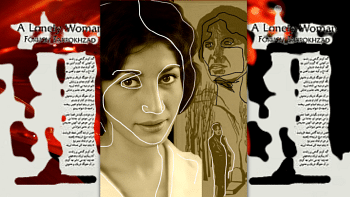Of ‘BONOBIBI’ and music as a form of storytelling

When Coke Studio Bangla released Meghdol's Bonobibi, their second song of season 2, listeners found themselves torn between loving the song and questioning it. Questioning as to why the song was done under the banner of Coke Studio, a project funded by an American-based multinational corporation; questioning what qualifies Meghdol, a band known for singing about urban life in Dhaka city, to sing about tales originating in the Sundarbans; and why the song didn't delve deeper into the history and background of the stories they were trying to tell. It has raised a wider question about how music plays a role in storytelling.
There are no notable books that compile the parables of Khona, which serves as part of the inspiration for the Coke Studio Bangla song. Khona's adages, which reportedly originated in the Indian subcontinent, have recently been compiled only in a handful of books like Khonar Bochon (Ovro Prokash, 2021) by Sabbir Hafez, and her origin story examined in books like Purvi Basu's Kingbodontir Khona O Khonar Bochon (Anyaprokash, 2015). The story narrates the prophetic powers of a girl who appears to Bengali king Bikram Aditya when his kingdom faces difficulties with their harvest due to unpredictable weather; her witty predictions help him turn his misfortune around.
Nor can one find the story of Bonobibi in its full, "verified" form in a recent novel; these stories exist primarily as word of mouth, while only a handful of widely recognised writers, such as Amitav Ghosh, have touched upon the story of Bonobibi in their works, such as in The Hungry Tide, Gun Island, and in his verse retelling of Junglenama.
As SK Mandal writes in Banbibir Pala (Gangchil Publisher, 2016), the first recorded texts mentioning Bonobibi were that of poets Bayanuddin and Munshi Mohammad Khater, circa 19th century, and it is thought that the tale originated in the Sundarban region around the 15th century with the emergence of Islam.
Through a stage play enacted in the Sundarban village of Lusibari in Amitav Ghosh's The Hungry Tide, Ghosh's protagonist Kanai learns how the story originated in Medina. "[H]ere lived a man called Ibrahim", the play recounts for Kanai, "a childless but pious Muslim who led the austere life of a Sufi faqir. Through the intervention of the archangel Gabriel, Ibrahim became the father of blessed twins, Bon Bibi and Shah Jongoli." The archangel informs the twins that "they were to travel from Arabia to 'the country of eighteen tides' — athhero bhatir desh — in order to make it fit for human habitation." Bonobibi's arrival in the jungle is accompanied by a prayer call, an azaan, and as the twins are attacked by–and win over–the demon king Dokkhin Rai, Bonobibi is seen to be generous in victory. One half of the tide country she leaves as forests to be ruled by Dokkhin Rai.
As SK Mandal writes, the story of Banbibir Keramati and Banbibir Jahuranama (or The Glory of Bonbibi as it appears in The Hungry Tide) has since been recreated in plays, musicals, and reworked to form parts of or the entirety of other narratives, though not to the extent that would allow them to gain mainstream recognition.
As poet, academic and literary critic Professor Kaiser Haq addressed in his session on The Goddesses of Bengal at this year's Dhaka Lit Fest, "Bonbibi is revered by everyone who lives in the Sundarbans. No one will venture into the forest, whether Hindu or Muslim, without going to the Bonbibi shrine and doing something ritualistic. She is the protector. Dokkhin Rai, the tiger god, is the threat. This is part of their daily life. This is the only example in Bangladesh where you have this kind of a cult which is still very alive. Elsewhere, Hindus have their own practices, Muslims have their own practices."
And so, these stories have persevered.
"We are not here to talk [exclusively] about Bonbibi, or about Khona's teachings, or even [SM] Sultan", Shibu Kumer Shill tells us, speaking about Meghdol's motivation to adapt Bonobibi and Khona's parables to contemporary Bangladeshi music. "We wanted to bring to the foreground the idea that even in [mediaeval] times, a narrative centred around a female protagonist existed–even before the Women's Rights Movement."
Meghdol's intention with Bonobibi was to identify and highlight women centric discourses that have been passed down for generations through oral traditions of storytelling. What they were looking for were regional folklores about women empowerment that often fall through the cracks compared to dominant and more popular literature.
However, Bonobibi is not the first instance in which stories have taken musical forms to reach out to a wider audience in South Asia. One of the most prominent examples is the genre of Qawwali, which often incorporates poetic verses and discusses historical figures and themes such as divine love and spiritual redemption.
Even though the use of musical instruments in Qawwali was initially prohibited and the form meant to be strictly lyrical due to its devotional nature, elements from Indian classical music travelling into Qawwali helped the genre evolve into its present form. One of its most significant influences was the poet and musician Amir Khusrau, whose devotional poem, Chhaap Tilak Sab Chheeni, has been adapted by notable qawwals across centuries, including the likes of Nusrat Fateh Ali Khan and the Sabri Brothers.
Other prominent poems-turned-songs from the region include Shikwa and Jawab-e-Shikwa by Muhammad Iqbal, which have been sung not only by the above-mentioned qawwals, but also in Coke Studio Pakistan.
As Fareed Ayaz and Abu Mohammad's raw vocals merge into Natasha Baig's Sufi rock music in Coke Studio Pakistan's adaptation of the poems, one cannot help but be in awe of the fusion created.
The poetic and devotional lyrics such as "Ai Khuda shikwa-e-arbab-e-wafa bhi sun le" (O God listen to the complaint of these loyal mortals) converging with the intense melody created by rock instruments adds a new dimension to the poetry; it shows the room for experimentation available with such poetic verses. Additionally, the seemingly rebellious nature of the poem Shikwa is given more depth by the electric guitar and the unconventional way in which it is sung, seeming to defy traditional modes of incorporating poetry into music. These experiments make the poems much more potent for a younger audience.
Such inclusion of literature in music has often allowed stories from one culture to be introduced within different groups of people, which has fostered intercultural exchange across religious, cultural and class divides.
As Anuradha Bhattacharjee and Shadab Alam note in their article "The Origin and Journey of Qawwali: From Sacred Ritual to Entertainment?", in the Journal of Creative Communications (2012), "Music was first formalized in India in connection with preserving the sruti texts, primarily the four Vedas."
Oftentimes, musical narrations of mythological tales, including the likes of the Ramayanas and the Mahabharatas, allow younger audiences to learn the more important parts of vast epics, which plays an important role in these stories being passed down from one generation to another.
"Our folk literature, which includes narratives and lyrics, as well as epigrammatic verses, have survived because they express something significant in our lives", says Professor Kaiser Haq, who authored The Triumph of The Snake Goddess (Harvard University Press, 2015). "Thus … at the end of [the month of] Sravan, there are performances of the Manasa tales in many villages."
When these stories are adapted to platforms like Coke Studio–which has built rapport over several years from their Pakistani and Indian counterparts–or when popular bands like Bangla or Lalon sing about the teachings of Lalon Shah, they become relatable for a wider range of audiences. Such adaptation from one medium to another has been carried across for centuries, for instance, Kazi Toufikul Islam Emon recreating Akhtaruzzaman Elias's 1996 novel Khwabnama as a theatre production for Prachyanat. It is, therefore, only natural transition that folktales be adapted to contemporary poetry and music.
However, questions may arise as to whether these stories, packed with geopolitical, social, and cultural nuances, are being appropriated–for instance, if and when they're not told by the locals of the originating story, or if feminist discourses are told by men, and so forth.
Sohini Alam of the band Khiyo believes that, "It is not a matter of who is allowed to tell what story, as long as the story gets amplified." She talked about the London-based, women-run Komola Collective arts company and their theatre adaptation of Bonbibi's story in Daughter of the Forest, which recreates the tale for a UK-based audience. Khiyo worked on the music for the play.
The band worked under the assumption that their mostly white, English-speaking and/or UK-based audience would not understand the lyrics. "So we give a one line synopsis of the song and what we mostly focus on is not necessarily the meaning of the lines but the overall vibe".
She explains, "Dance and music, they're languages already […] and if you can connect with people on an emotional level, the fact that they don't understand every single word is less of a barrier."
Kaiser Haq echoes this idea: "The fact that our pop bands are using folk materials testify to the endurability of our folk culture. I am not bothered by charges of (mis)appropriation. We should simply respond critically to a song and appreciate it if it uses the folk material interestingly."
"It's a sign of good health in a culture when those involved in different media (music, theatre, film, writing) produce new versions of traditional stuff", he says.
Shibu Kumar Shill adds, "It is connection and relatability to a story through emotions that win over, and adapting to different artforms, especially music, adds dimensions and new perspectives to traditional stories–that is what we intended with Bonobibi."
In their song, the celebration of powerful women like Bonbibi and Khona from traditional folktales converge to create a narrative that emphasises the roles these characters play in nature, as well as in forming the cornerstones of various cultural practices.
"Joishtho te tara fote / tobe janbe borsha bote (when stars shine during the month of Joishtho, it signals of Monsoon)", Meghdol sings in Bonobibi, and as listeners, we get a sense of the prowess Khona possessed. When I realise that this adage originated sometime between 800 to 1200 AD and is based on later scientific findings, it attests to me the power of nature and of the entity who channels such power. Their lyrics further say, "Ei prithibir mora ghaashe, tobu muktir phul fote" (Flowers of freedom still grow from the wilted grass of the Earth)". The verses remind us that a withering, war-torn Earth can still birth new life and hopes of freedom. In not so many words, the song echoes the innate force of mother nature and of Bissho Mata (Mother Earth), and shows us why we refer to the Earth as a mighty feminine entity.
Maisha Syeda is the sub editor of Daily Star Books. Hrishik Roy is an intern at Daily Star Books.


 For all latest news, follow The Daily Star's Google News channel.
For all latest news, follow The Daily Star's Google News channel. 













Comments